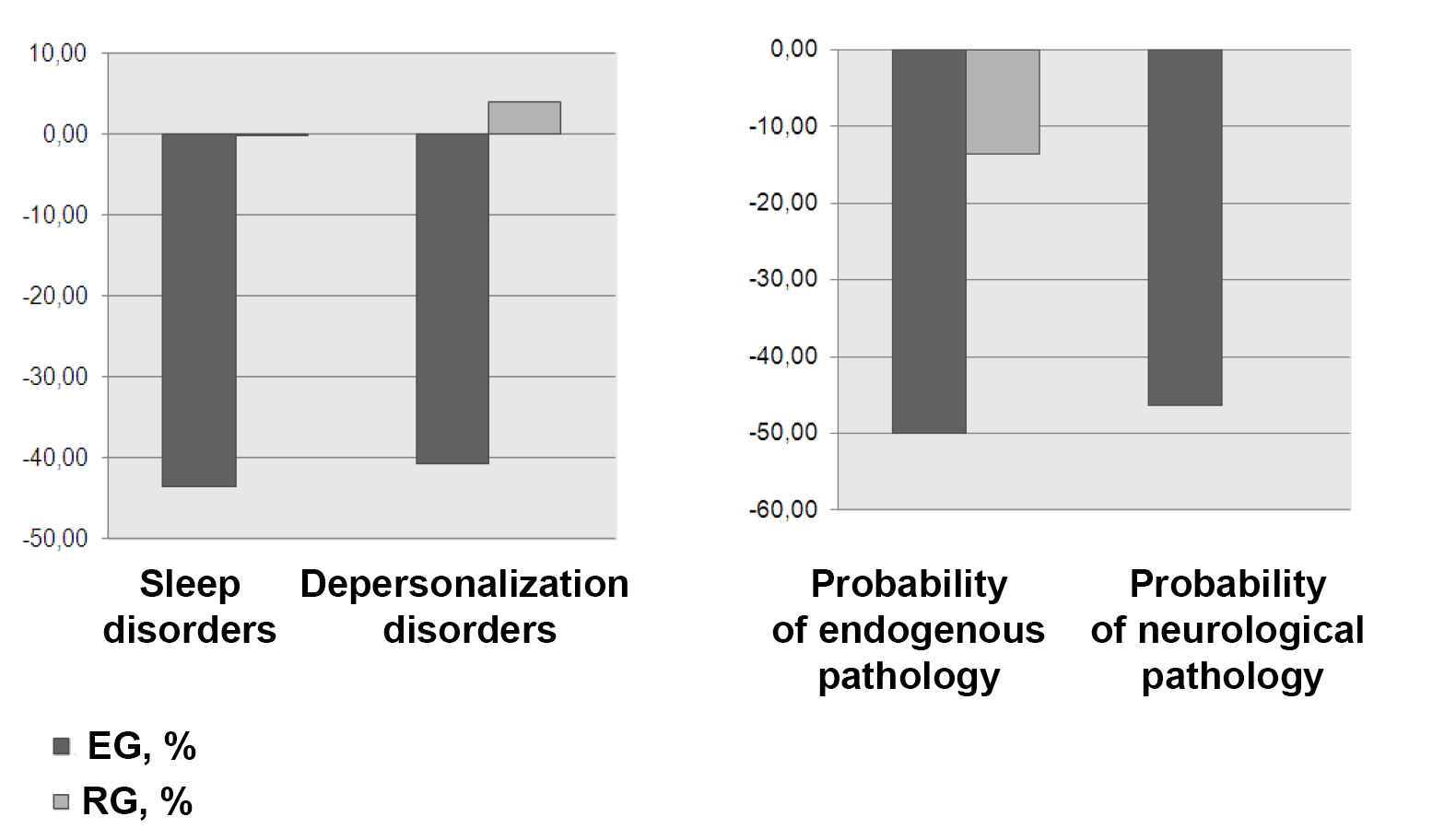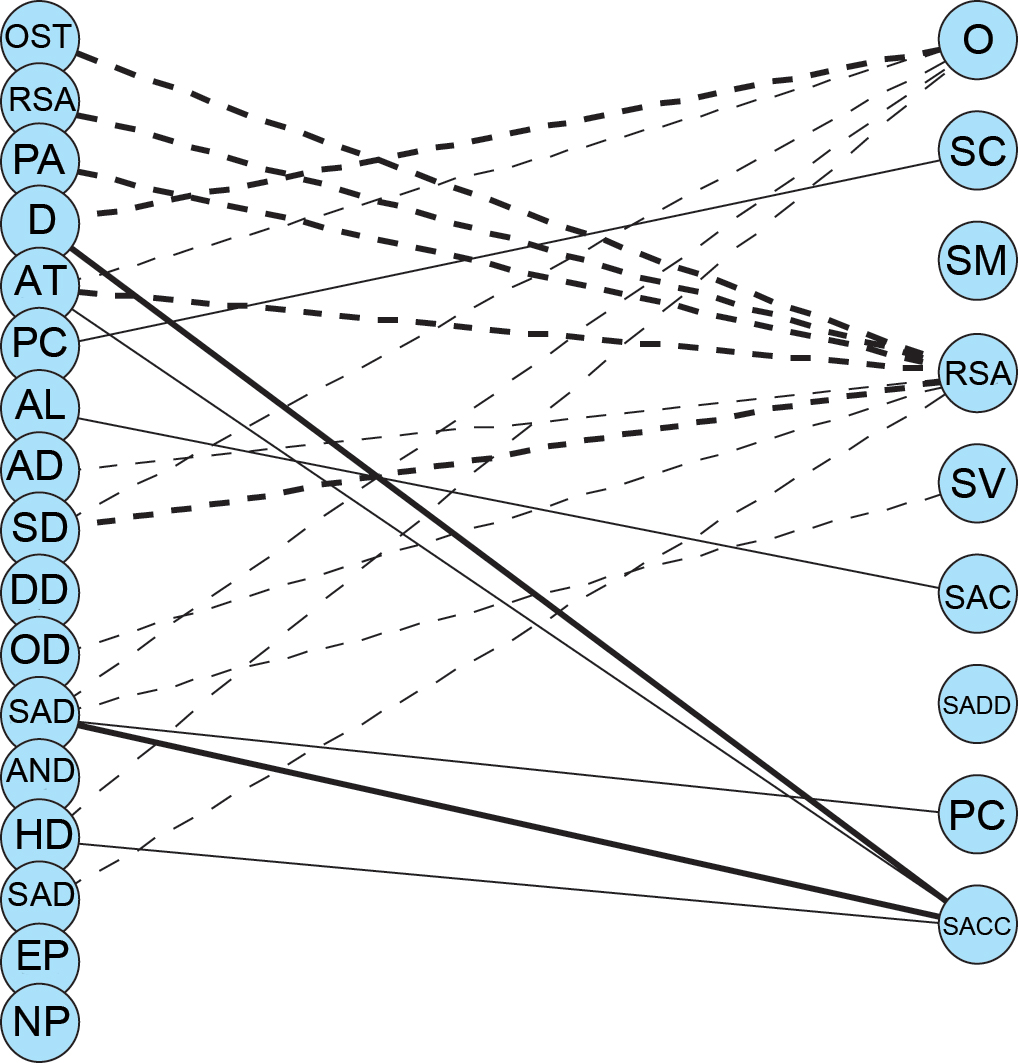Female students' aerobics with elements of mental and physical self-control to correct self-appraisal and neurotic conditions
Фотографии:
ˑ:
PhD, Associate Professor O.L. Petrozhak1
PhD, Associate Professor I.R. Stovba1
PhD, Associate Professor N.V. Stolyarova1
Dr.Hab., Associate Professor E.A. Cherepov1
1South Ural State University (National Research University), Chelyabinsk
Keywords: deadaptation, self-control, body-focused mental correction, neurotization, self-attitude, self-awareness.
Background. Today in academic preventive psychological support activities a due priority needs to be given to timely efforts to detect and rate mental and physical conditions including individual traits and responses to stressors determined by interpersonal relationship, behavioural needs, motivations for activity and adaptability to academic environments [1, 3, 5]. Systemic fitness practices are known to be beneficial as stress-control and adaptability improvement tool motivating trainees for determined efforts to build up their competency in and acceptance of healthy lifestyles [1, 4, 7].
A special emphasis on the phenomenology of corporality as another promising avenue for the studies with practical application of body-centred mental correction models makes it possible to integrate a variety of mental and physical individual qualities building aspects and components [4]. Training models designed to help master basics of mental and physical self-control mechanisms in a special physical education process with practical application of acquired skills gives the means to the students to find the best ways to control their body responses and effectively change physiological characteristics of the body. Thanks to individual reflexive self-control process closely interrelated with mental and physical control mechanisms they can effectively generalise and apply self-diagnostics, self-control, self-correction and self-development experience [3, 4].
Objective of the study was to analyse the female students’ mental and physical conditions with an emphasis on the general neurotic conditions and self-diagnostics aspects versus their adaptation to aerobic loads, with basics of mental and physical self-control provided by the applied corrective health program.
Methods and structure of the study. Tests under the study lasted one academic year prior to Semester 1 (October 2015 г.) and after Semester 2 at the Physical Education and Health Department of South Ural State University (National Research University, SUSU). Experimental Group (EG) was composed of the first-to-third-year SUSU female students (n = 126) mastering the Aerobics with Self-control Basics course; and the Reference Group (n = 103) was made of their peers engaged in the Classical Aerobics course.
The educational experiment in the EG was designed to give a special priority in the aerobics mastering process to extra practices designed to help form a corporal Self-image, master muscular and respiratory relaxation techniques and basics of body-focused mental gymnastics, and develop emotional self-control abilities. The aerobics training course lasted one academic year from September through May, with three 90-min sessions per week, and with special mental-and-physical self-control exercises taking 10-15min in every session. Both of the groups were tested by two sets of tests including the Overall Neurotization Rating Tests (ONRT) and Self-attitude Rating Tests (SART) [6].
Study results and discussion. The prior tests showed the highest rates in both of the groups in the affective lability rating test and asthenic disorders rating test (57.2% each); the finding being indicative of increased fatigue, shortage of energy for activity, emotional imbalance, inefficiency of cognitive processes etc. The students were also tested with the lack of confidence and independence and high dependence on other people: see Table 1 hereunder.
Table 1. ONRT-rating questionnaire survey data of the EG versus RG as of the beginning of the academic year, М±m
|
Rates, points |
EG |
RG |
p |
|
Overall index, sten: |
5,07±0,66 |
4,74±0,71 |
>0,05 |
|
Sleep disorders |
11,15±1,73 |
21,79±3,68 |
<0,01 |
|
Depersonalization disorders |
8,63±1,39 |
19,05±3,37 |
<0,01 |
|
Autonomic system disorders |
12,41±1,63 |
15,16±2,72 |
>0,05 |
|
Probability of endogenous pathology |
0,11±0,02 |
0,32±0,06 |
<0,01 |
|
Probability of neurological pathology |
0,30±0,05 |
0,58±0,11 |
<0,05 |
The above data on the dominating neurotic disorders at the onset of the study were interpreted as indicative of the notable overstrain of the subjects’ adaptation mechanisms; albeit it should be noted that the detected neurotic indications were occasional in fact.

Figure 1. Variations of the neurotisation rates on the scales of “sleep disorders”, “depersonalization disorders” and “probability of neurological/ endogenous pathologies” in both groups, %
The final tests showed notable drops in the neurotisation levels as verified by every scale of the ONRT tests in both of the groups. The EG, however, showed a higher progress on the “sleep disorders” and “depersonalization disorders” scales, with improvements by 43.5% and 40.7%, respectively: see Figure 1. The test data were indicative of a good progress in the sleep disorders control, prudent management of the academic loads and physical activity. At the same time the subjects were found to better perceive the environment and themselves as a personality and better control their behaviour.
Furthermore, the tests found significant intergroup differences (p<0/05) on the “Probability of endogenous pathology” scale, with the EG rate found to drop by 50% versus only 13.5% in the RG; and on the “Probability of neurological pathology” scale, with the EG rate found to drop by 46.4% versus no progress in the RG. These test data demonstrated a high progress of the EG in adaptation to stressors that may trigger somatic disorders and/or physiological pathologies.
The self-attitude test data were interpreted by analysis of 9 test rates collectively indicative of the self-attitude of the subject. Both groups were rated high (7-8 sten points) on the “self-valuation”, “self-acceptance” and “self-management” scales that shows high importance and value of own self and expectations of rather positive than negative attitudes to own personality and behaviour from the surrounding people. It should be noted on the other hand that own motivations, goals and actions are not always adequately correlated with the inner actual Self and this implies the internal dispute of the Self-that-must with the Self-that-wants triggering a variety of difficulties in the control and management of own emotions, desires and sentiments.
Analysis of the Overall Neurotization Rating Test (ONRT) and Self-attitude Rating Test (SART) rates of the sample showed the highest proportion of the negative correlations on the “openness-closeness” SART scale (З) with the “reflected self-attitude” (SA) ONRT scale (р<0.001); and positive correlations on the “self-accusation” SART scale: see Figure 2. The study data and analyses demonstrated that the higher is the internal integrity and openness to own Self and other people the more positive is the self-attitude (i.e. perception of own Self as an independent and wilful person) and the lower is the neurotization rate; with the subjects being less prone to unreasonable anxiety and lability of the nervous processes.

Figure 2. Correlations of the ONRT and SART rates in both groups prior to the experiment
Note: solid line shows a positive correlation with p<0.05; solid bold line shows a positive correlation with p<0.001; dashed line shows a negative correlation with p<0.05; and dashed bold line shows a positive correlation with p<0.001.
Abbreviations: ONRT: PA phobic and anxiety disorders; D depressive disorders; АT affective tension; РС sleep disorders; AL affective lability; АD asthentic disorders; SD sexual disorders; DD depersonalization disorders; ОD obsessive disorders; SAD social anxiety disorders; AND anankastic (obsessive-compulsive) disorders; HD hypochondriacal disorders; SAD somatoform autonomic disorders; EP probability of endogenous pathology; NP probability of neurological pathology.
SART: O openness-closeness; SC self-confidence; SM self-management; RSA reflected self-attitude; SV self-valuation; SAC self-acceptance; SADD self-addiction; PC internal proneness to conflict; SACC self-accusation
The post-experimental EG tests showed a fall in the numbers of correlations, particularly the numbers of the strong ONRT-SART correlations and their vectors.
The study data showed no correlations of the SART “self-accusation” rates with the ONRT rates. Furthermore, the numbers of ONRT correlations with the SART “openness-closeness” rates notably dropped; the ONRT correlations with the “reflected self-attitude” stayed the same; and we found a strong negative correlation of the SART “self-acceptance” rate with the ONRT “social anxiety disorder” rate.
The RG test data showed an opposite picture: we found 34 post-experimental correlations versus 21 pre-experimental ones. Correlations with the SART “openness-closeness”, “reflected self-attitude” and “self-accusation” rates stayed unvaried. We found a strong difference of the pre- and post-experimental “self-accusation” rates interpreted as indicative of exhaustion of the adaptation mechanisms by the end of the academic year associated with the growing anxiety and emotional tension.
Conclusion. The study diagnosed 57% of the first-year female students with an increased neurotization conditions that cause the highest effects, as verified by the correlation analysis, on the “openness-closeness”, “reflected self-attitude” and “self-accusation” test rates.
The corrective aerobics course with mental-and-physical self-control basics was found beneficial as it gave the means to notably mitigate the neurotization by the end of the year – with the “sleep disorders”, “depersonalization disorders”, and “probability of endogenous/ neurological pathologies” rates tested to drop by 43.5%, 40.7% (p<0.01) and 50.0% (p<0.05), respectively. The applied mental condition correction program with the mental-and-physical self-control basics may be recommended to improve the female students’ academic adaptation and mental-and-physical conditions.
References
- Vardanyan Y.V., Bylkina T.G. Optimizatsiya konfliktoustoychivosti i stressoustoychivosti v kontekste psikhologicheskoy bezopasnosti studenta [Optimization of conflict and stress resistance in context of student's psychological safety]. Mezhdunar. nauch.-prakt. konf. "Rezultaty nauchnykh issledovaniy" [Proc. Intern. res.-pract. conf. "Scientific research results"], Ufa, 2016, pp. 149 –152.
- Iovlev B.V., Shchelkova O.Y., Ababkov V.A., Ananyeva E.I. Oprosnik nevroticheskikh rasstroystv – simptomaticheskiy (ONR-SI) [Survey of neurotic disorders - symptomatic (SND-SI)]. Available at: http://megaobuchalka.ru/3/18062.html.
- Kolesnikova E.I. Samootsenka v strukture sotsialno-psikhologicheskoy kompetentnosti studentov vuza [Self-appraisal in the structure of socio-psychological competency of university students]. Vestnik Samarskoy gumanitarnoy akademii. Seriya: Psikhologiya, 2011, no. 2, pp. 58–76.
- Korotaeva A.E., Ovsyanitskaya A.V. Nevroticheskie sostoyaniya studentov starshikh kursov v zavisimosti ot ikh uspevaemosti [Ratio of neurotic conditions and academic progress of senior students]. Permskiy gosudarstveny universitet im. E.A. Vagnera. Meditsinskie nauki, 2015, no. 6 (37), vol. 2 (41), pp. 113–114.
- Solovyeva O.V., Solovyeva E.V. Lichnostnaya samoregulyatsiya buduschikh pedagogov: fenomenologiya i razvitie [Self-control of future teachers: phenomenology and development]. Stavropol: Servisshkola publ., 2010, 180 p.
- Stolin V.V., Pantileev S.R. Metodika issledovaniya samootnosheniya (test-oprosnik MIS) [Self-attitude rating tests (SART inventory)]. Available at: http://psychok.net/testy/258-metodika-issledovaniya-samootnosheniya-test....
- Chukhril I., Soci Psychological peculiarities of disadaptation formation in young people with physical dysfunction. SCIENCE AND EDUCATION, 2016, no. 9, pp. 203–210.
Corresponding author: cherepov.e@mail.ru
Abstract
Objective of the study was to analyse the female students’ mental-and-physical conditions with an emphasis on the overall neurotic conditions and self-appraisal elements versus their adaptation to aerobic loads – with basics of mental and physical self-control provided by the applied corrective health programs. The study data demonstrated correlations of the somatic and psychological aspects of the emotional conditions found by the special questionnaire survey method designed to rate self-appraisal deficiencies and neurotic disorders. The mental and physical conditions were found associated with excessive neurotization in 57% of the subjects. The applied mental condition correction program was tested to mitigate the neurotic conditions as verified by a variety of the test rates, improve the self-appraisal rates and alleviate the mental deadaptation effects in the female students.



